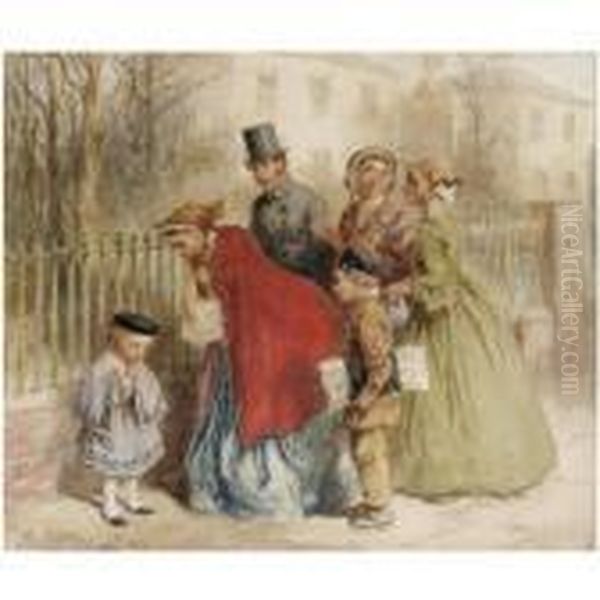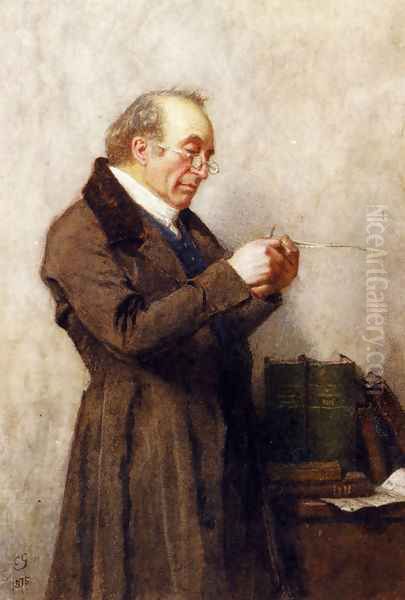Charles Green (1840-1898) stands as a significant, if sometimes overlooked, figure in the rich tapestry of British Victorian art. Primarily celebrated as a painter and illustrator, he excelled in capturing the essence of genre scenes, historical narratives, and literary subjects, particularly through the medium of watercolour and the demanding craft of book illustration. His work is intrinsically linked with the burgeoning print culture of the 19th century and the golden age of British illustration, often referred to as "The Sixties School."
Early Life and Artistic Beginnings
Born in London in 1840, Charles Green embarked on his artistic journey at a time when the city was a global hub for artistic and literary production. His formative training was crucial in shaping his meticulous style and his understanding of narrative composition. In 1859, he became an apprentice to the renowned wood-engraver Josiah Wood Whymper. This apprenticeship was pivotal, as Whymper's studio was a training ground for many aspiring illustrators. Wood engraving was the dominant method for reproducing images in books and periodicals before the advent of photomechanical processes, and proficiency in drawing for the engraver was an essential skill.
Green's time with Whymper would have immersed him in the practicalities of illustration, learning how to create designs that translated effectively into print. This experience undoubtedly honed his draughtsmanship and his ability to convey complex scenes and character emotions with clarity and precision. His younger brother, Townley Green (1836–1899), was also an artist, suggesting a familial inclination towards the arts.
Artistic Style and Influences
Charles Green developed a distinctive artistic style characterized by its detailed realism, sensitive portrayal of human figures, and adept handling of watercolour. He was particularly skilled in creating lively and engaging genre scenes, often imbued with a gentle humour or pathos, reflecting everyday Victorian life or historical settings. His compositions were carefully constructed, with a keen eye for anecdotal detail that brought his subjects to life.

A notable influence on Green's watercolour technique was William Henry Hunt (1790-1864), a prominent watercolourist known for his meticulous still lifes and rustic figures, often executed with a stippling technique. Green adopted and adapted this method, using fine brushstrokes and a pointillist-like application of colour to build up texture and form, especially in his detailed rendering of fabrics, interiors, and facial expressions. This technique lent a particular vibrancy and depth to his watercolours.
His illustrations, while designed for black and white reproduction, carried the same attention to character and setting. He understood the importance of visual storytelling, ensuring his images not only complemented the text but also enriched the reader's experience.
A Prolific Illustrator: Bringing Literature to Life
Charles Green's most enduring legacy lies in his contributions as an illustrator. He was a key figure among "The New Men of the Sixties," a group of talented artists who revolutionized British illustration during the 1860s. This era saw an explosion in the popularity of illustrated books and magazines, driven by an increasingly literate public and advancements in printing technology.
Green's work appeared in numerous prestigious periodicals of the day, including Once a Week, The Cornhill Magazine, and London Society. These magazines provided a vital platform for illustrators, allowing their work to reach a wide audience. He also contributed to significant illustrated book projects.
His illustrations for Cassell's Illustrated Family Bible (1859-63), Hymns of Old England (1864, with others), and The Life and Lessons of Our Lord (1864) demonstrate his ability to handle sacred and historical subjects with dignity and skill. He also illustrated Pictures from English Literature (1870), showcasing his versatility across different literary genres.
Perhaps his most celebrated illustrations were for the works of Charles Dickens. Green was one of the artists chosen to illustrate the Household Edition of Dickens's novels, published by Chapman & Hall in the 1870s. He provided memorable illustrations for The Old Curiosity Shop and Barnaby Rudge, capturing the unique blend of caricature, social commentary, and melodrama that defined Dickens's writing. His interpretations of iconic characters like Little Nell, Quilp, and Barnaby Rudge himself, resonated with contemporary readers and have since become part of the visual iconography associated with these classic novels. Working on Dickens's texts placed him in the company of other esteemed illustrators like Hablot Knight Browne ("Phiz") and George Cruikshank, who had defined the visual world of Dickens for earlier generations.
Genre Paintings and Exhibitions

Beyond his prolific work as an illustrator, Charles Green was an accomplished painter, primarily in watercolours. His subjects often mirrored those of his illustrations: historical scenes, literary interpretations, and depictions of contemporary life. His paintings were noted for their narrative clarity, meticulous detail, and often, a warm, engaging quality.
One of his well-known paintings, "Here They Come!" (exhibited 1866, now in the Victoria and Albert Museum), depicts a bustling crowd eagerly awaiting a procession, showcasing his skill in composing complex group scenes and capturing individual expressions. Other works explored themes of social interaction, domestic life, and historical anecdotes, always with a strong storytelling element.
Green was an active participant in the London art world. He began exhibiting his works early in his career, notably at the Royal Academy of Arts, where he showed paintings regularly from 1862 until 1883. His skill in watercolour was particularly recognized by his peers. He was elected an Associate of the Royal Institute of Painters in Water Colours (ARI) in 1864 and became a full Member (RI) in 1867. This institution was central to the promotion and exhibition of watercolour painting in Britain. His contributions were also recognized internationally, as he was elected an honorary member of the Royal Academy of Fine Arts in Vienna.
The "Sixties School" and Artistic Circle
Charles Green was an integral part of the "Sixties School" or "The Idyllic School," a term used to describe the illustrators who flourished in Britain during the 1860s. This was not a formal school or movement with a manifesto, but rather a loose association of artists who shared a commitment to high-quality draughtsmanship and expressive illustration. They benefited from skilled wood-engravers like the Dalziel Brothers and Joseph Swain, who could faithfully translate their intricate drawings onto the woodblock.
Green's contemporaries within this vibrant circle included some of the most talented artists of the era. He formed friendships with fellow illustrators such as Frederick Walker, George John Pinwell, and John William North, all of whom made significant contributions to the visual culture of the period. James Mahoney was another associate. These artists often worked for the same publications and shared a common artistic milieu.
Other prominent figures associated with "The Sixties School" whose work Green would have known, and who helped define this golden age of illustration, include John Everett Millais (though more famous as a Pre-Raphaelite painter, he was a prolific illustrator), Frederick Sandys, Arthur Boyd Houghton, Matthew James Lawless, and John Tenniel (immortalized by his illustrations for Alice's Adventures in Wonderland). The collective output of these artists set a new standard for book and magazine illustration, influencing generations to come.
Green was also a member of the Langham Sketching Club, joining in 1864. This club, officially The Artists' Society, provided a space for artists to practice life drawing and composition, and to exchange ideas. He was also a member of the Savage Club, a bohemian gentlemen's club in London with many members from the arts and literary worlds. These affiliations underscore his active engagement with the artistic community of his time.
Later Life and Legacy
Charles Green continued to work steadily throughout his career, maintaining his reputation as a skilled watercolourist and illustrator. His dedication to his craft and his ability to connect with a broad public through his accessible and engaging imagery ensured his popularity during his lifetime.
While the rise of photomechanical reproduction processes towards the end of the 19th century began to change the landscape of illustration, the skills honed by artists like Green—strong narrative composition, character development, and attention to detail—remained highly valued. His work for Charles Dickens, in particular, helped to solidify the visual interpretations of some of English literature's most beloved characters.
His mother, Marianne Green, reportedly had connections with literary figures, including the circle of the poet John Keats. This familial background might have fostered an early appreciation for literature that later manifested in his successful career as an illustrator of classic texts.
Charles Green passed away in Hampstead, London, on May 4, 1898. His death marked the passing of a dedicated and talented artist who had significantly contributed to the visual culture of the Victorian era. His paintings and illustrations remain important documents of their time, offering insights into Victorian tastes, social customs, and literary preoccupations.
Today, Charles Green's works are held in various public collections, including the Victoria and Albert Museum in London, and continue to be appreciated for their technical skill, narrative charm, and historical significance. He remains a key representative of a period when British illustration reached a remarkable peak of artistic achievement, influencing not only how people read and visualized literature but also shaping the broader visual landscape of the 19th century. His legacy is intertwined with that of the great Victorian novelists and poets whose works he helped bring to visual life for a captivated public.